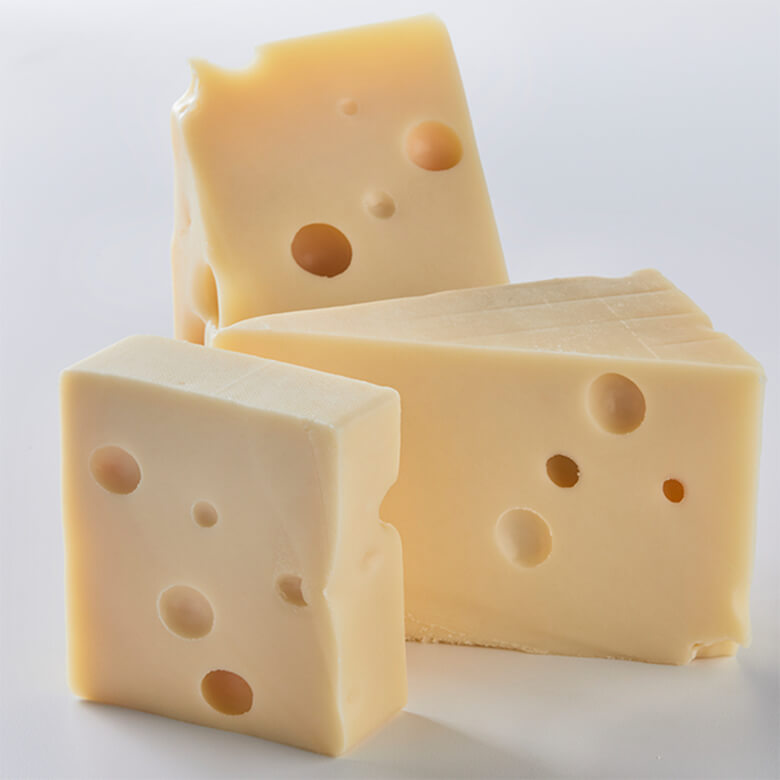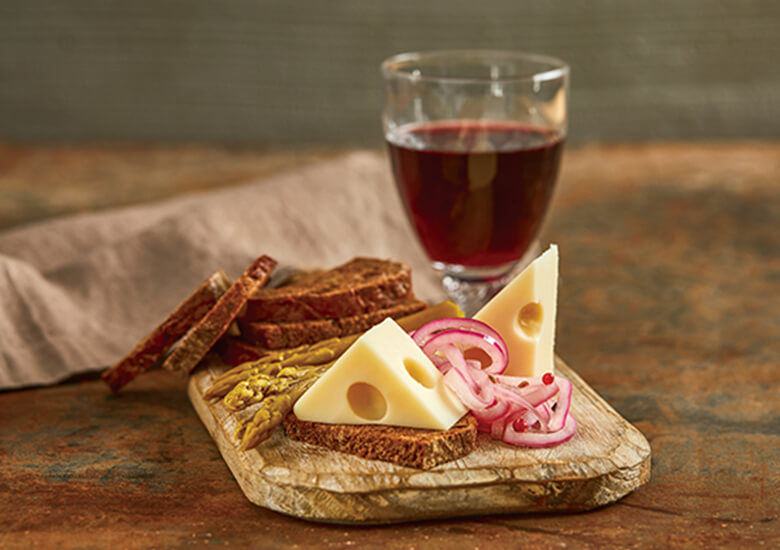It's hole-y, it's buttery smooth, it's swiss cheese! Although our inner child still dreams of a moon made of swiss, we couldn't live without this rindless masterpiece here on Earth. Read on to learn how this iconic cheese made its way to Wisconsin and why it deserves a place on your next cheese board.
Cheese History: The Story Behind Swiss
Swiss cheese was born in a lush valley in west central Switzerland—a region called Emmental. This family of cheese is known as alpine-style, created in high-altitude pastures.
Swiss cheesemakers grazed their cows high in the mountains during the warm months of summer before returning to the safety of the lower elevations as the seasons changed. Swiss cheeses were traditionally made in large formats in order to preserve the milk from the summer as long as possible.
When Swiss immigrants came to Wisconsin—Green County, to be specific—in the late 1800s, they brought this cheesemaking technique with them. As the Wisconsin dairy industry boomed and Wisconsinites developed an affinity for this delicious style of cheese, the alpine-style offerings evolved into emmentaler, swiss, and baby swiss. And we’re so glad it did!
All About Swiss Cheese

What does swiss cheese taste like?
Swiss cheese is sweet, mild, and nutty—everything an alpine-style cheese should be! When you first pick up a beautiful slice of swiss, you’ll notice its slightly yellow color and nutty aroma. Upon tasting it, you may appreciate how sweet and smooth swiss is.
That’s because it has a lower acidity than most other cheeses, which allows for a silky-smooth texture. Swiss cheese also has less salt than other cheeses, which means that it’s an excellent choice to pair with accompaniments like pretzels or salted nuts.
How is swiss cheese made?
Swiss cheese begins like most cheeses: a helpful combination of enzymes called rennet is added to fresh Wisconsin milk, which creates solid curds and liquid whey. From there, the curds are soaked in a brine and heated.
The brine mixture has low acidity and low salt, which means it’s a very happy home for the bacteria cheesemakers need to make swiss! As the mix is heated, the bacteria grow, producing lots of carbon dioxide. Meanwhile, the cheese absorbs salt, releases water, and traps those gas bubbles inside—creating the holes you know and love!
What’s the difference between swiss and baby swiss?
Both swiss and baby swiss are delicious, but there are some distinct differences between the two. Swiss cheese originates in, well, Switzerland, while baby swiss is an American creation.
Baby swiss is only aged for about a month, while traditional swiss cheese is aged for anywhere from two months to many years. Because of that, baby swiss is creamy, nutty, and great for melting. Baby swiss is also produced in smaller wheels and has a more consistent texture with smaller holes.
Why does swiss cheese have holes?
Swiss cheese develops its iconic holes as a result of the cheesemaking process. In a nutshell, cheesemakers carefully add specific bacterial cultures that slowly release carbon dioxide, making little pockets of air called "eyes” during the aging process.
Must-try Wisconsin Swiss Cheeses

Hook’s Cheese Company One Year Swiss: Julie and Tony Hook have been making Wisconsin cheese for over 40 years at Hook’s Cheese Company. Their One Year Swiss is a classic example of a Wisconsin-style swiss, with a mild, buttery flavor and smooth texture.
Deppeler's Baby Swiss Cheese: This worldwide award winner from Chalet Cheese Cooperative is made with whole milk, which lends a super creamy and buttery flavor. It’s also very meltable, so be sure to try it melted on a crusty baguette or draped over roasted potatoes.
Edelweiss Creamery Emmentaler: This cheese is the result of Master Cheesemaker Bruce Workman and Edelweiss Creamery’s quest to combine Old World heritage with Wisconsin’s unique milk. This emmentaler is crafted in a traditional copper kettle and produced in the form of a 180-pound wheel of cheese! That’s got to be at least enough cheese for…three servings.
Carr Valley Aged Swiss: Like most cheeses, as this swiss cheese ages it develops a deeper, more complex flavor. Carr Valley’s swiss is aged for two years, resulting in a robust and nutty cheese wonderful for snacking on its own or stacking atop dark rye bread.
Pairing Swiss Cheese

What beer goes well with swiss cheese?
A rich and malty beer, like a doppelbock or amber ale, pairs well with the sweet, nutty, and creamy Swiss. If you’re planning an Oktoberfest-themed cheese night, you’ve got a great start with swiss cheese and beer!
What wine pairs best with swiss cheese?
Crisp, dry white wines pair well with swiss cheese. Try a gewürztraminer or a riesling for a refreshing flavor combination.
What spirits should I have with swiss cheese?
When you’re in the mood for something a little stronger, try pairing swiss with grappa or fruit brandies. These sweeter spirits balance the nuttiness of the cheese.
What accompaniments should I serve with swiss cheese?
Since swiss cheese has a lower salt content you can pair it with salty sides, and it will be perfectly balanced, as all cheese plates should be. Cured meats, like saucisson sec or prosciutto, are great with swiss cheese. Pretzels or sesame sticks add a nice crunch and round out a cheese board.
If you’re ready to take a deeper look into the world of cheese pairing, we recommend starting with our beginner’s guide to cheese pairing.
Got your eye on some Wisconsin swiss cheese?
If all this talk of swiss has gotten you hungry for a cheese tasting, you can get Wisconsin’s finest cheeses delivered right to your door with our continuously updated list of cheesemakers and retailers that allow you to order cheese online. Award-winning Wisconsin Cheese is just a click away!
Craving something else? Choose from our selection of over 400 recipes featuring Wisconsin cheese. Don’t forget to share your creative cheesy creations with us on Facebook and Instagram.

If you liked this article, check out these related ones
